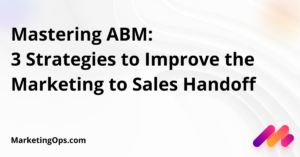It’s nearly impossible to comprehend the amount of data available to businesses today. More than 2 quintillion bytes of data—that’s 18 zeroes—are created in a single day. What are marketers doing with all that information?
They’re finding better ways to sell, of course.
Using data-driven models of consumer behavior, marketing teams are optimizing the customer experience by personalizing every phase of the sales funnel. In a nutshell, these models, known as predictive algorithms, use math to improve the lives of buyers and the businesses that sell to them.
What Is an Algorithm?
Put simply, an algorithm is a set of instructions for answering a particular question. A flowchart is an example of a straightforward algorithm.
Algorithms are used to answer business questions at scale using automated reasoning. Some of them can even predict events with varying degrees of accuracy.
These predictive algorithms make use of historical data. That’s right—whether you’re aware of it or not, companies everywhere are using what you have done to determine what you will do.
Predictive Algorithms in Everyday Life
Most consumers are blissfully unaware of the ways predictive algorithms have made their lives simpler. The truth is, these models are applied in just about every field of business.
When you finish binging a series on Netflix, it always seems to offer up something just as interesting to watch next. It makes these recommendations using its Cinematch algorithm, which considers factors like popularity, score, and similarity.
Another example is the algorithm used by Amazon, one of the pioneers of predictive modeling. The ecommerce giant started with basic traffic tracking measurements, but it’s evolved significantly over the years. Now, when a customer views a product, they see “frequently bought together” suggestions for upselling and reminders of “previously viewed items” for retargeting.
Digital giants aren’t the only ones using predictive models, though.
A trip to an NFL game, for example, is a data-collection bonanza, with the venue and organizers analyzing multiple factors to elevate the fan experience. The scanners at the gate don’t only scan for tickets—they also monitor crowd levels and seat preferences. If the venue “anticipates” inclement weather, shops put out ponchos and umbrellas. Those always seem to appear just in time, don’t they?
Machines vs. People: What Works Best?
Predictive models sound like a good option for analyzing data, but why can’t you just have a person do it?
Of course, Susan in accounting could probably build a great spreadsheet for reviewing and interpreting all your data, but it might not be in your company’s best interests to ask her to. Here are a few reasons why relying on predictive algorithms over human power makes more sense:
- Volume of data: Predictive models deal with thousands (if not millions) of data points. That’s far too much information for humans, or Excel, to handle.
- Efficient use of resources: As a human, it’s faster to train a model once and then let it run automatically compared to manually running a model each day. Plus, the brainpower and experience of the humans on your team can almost certainly be put to better use elsewhere.
- Real-time solutions: With a predictive model, you don’t have to wait for regular office hours to receive results. When new data is available that meets your parameters, your model will be hard at work making predictions.
How a Predictive Model Benefits Sales
Businesses wouldn’t be jumping through algorithmic hoops if there weren’t something in it for them. Whether you’re a massive SaaS company or a small business owner, competition is fiercer than ever. To rise above in a crowded market, you need to find more efficient ways to use your data.
Improved lead scoring
Regardless of how many leads your marketing efforts generate, it’s an unfortunate fact that those leads aren’t tied to any measurable revenue numbers. But bringing on a predictive algorithm can help target your efforts toward revenue building.
With predictive models, you’ll be able to aggregate thousands of data points based on any parameters you select. That means you can get a reliable revenue estimate in real-time as you generate new leads.
For example, you can label leads with particular characteristics as “good fit” leads and others as “bad fits.” Then, if a “good fit” lead has followed up a certain number of times, the algorithm might compare that number with past sales data to determine how likely they are to buy and how much they’re likely to spend.
To make things even easier, the algorithm can distill all of a lead’s data into a single lead score. With lead scoring, sales teams can rank leads and focus their time on the best ones.
Efficient ad spending
Facebook ad spending reached a record high of $1.57 billion in 2019. Over half of consumers have reported that the platform influences their online and offline purchases. But advertising on Facebook isn’t simple—or cheap.
Using predictive algorithms, it’s possible to optimize your Facebook ad spending. By predicting the value of each lead and focusing your spending where it counts, you’ll significantly reduce the cost of the great leads you’re after.
Streamlining connections with website leads
Even when a customer wants to give a business their money, they might still jump ship if they have to wait too long for that initial connection. The faster a company can schedule a lead, the better chance they have of converting them to a paying client.
Predictive modeling that uses historical and third-party data can determine if a lead is a good fit in real-time. As soon as a lead is qualified, analytics software can put them on the fast track, immediately prompting them to book a meeting with a sales representative.
Predictive Algorithms: A Win-Win
As technology advances, predictive algorithms will continue to trim down what used to take marketers ages to accomplish. These algorithms are the perfect tools for helping sales teams stay competitive in an increasingly data-driven world—all while making the consumer experience breezier than ever.






